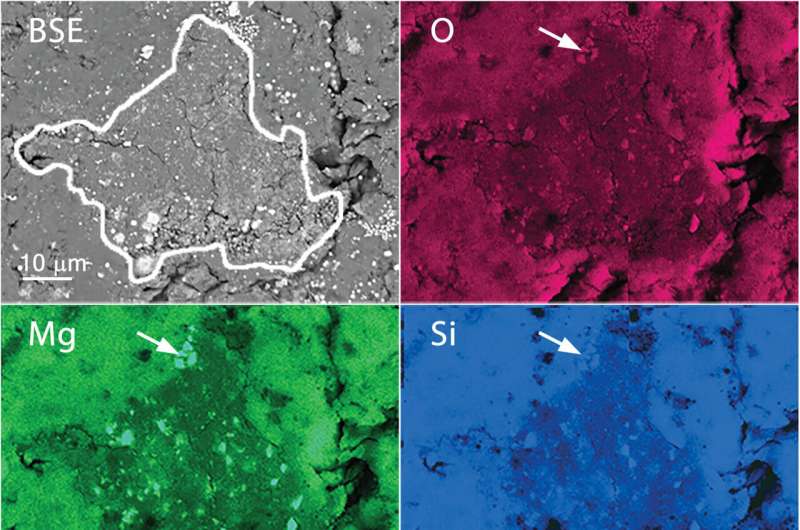Backscattered electron (BSE) image and elemental maps of a region of grain C0002 containing primitive clast 1, outlined in the BSE image. This clast is rich in Fe and S and depleted in Mg, Si, and O compared to the surrounding matrix. It also contains Mg-rich silicate grains that are likely olivine. White arrows indicate a cluster of these grains. Credit: Science Advances (2023). DOI: 10.1126/sciadv.adh1003
A large international team of space scientists and geochemists has found preserved presolar silicate grains in surface samples collected from the Ryugu asteroid by the Japanese space probe Hayabusa2 in 2018 and 2019 and returned to Earth in 2020. In their study, reported in the journal Science Advances, the group found two clasts (unique and identifiable fragments of rock) in Ryugu samples.
In 2014, JAXA sent the Hayabusa2 craft into space—its multi-year mission was to meet up with the asteroid Ryugu, collect samples and then return to Earth. By all accounts, the mission was wildly successful. Hayabusa2 dropped a return capsule filled with asteroid samples into the Earth's atmosphere at the end of 2020 at the Woomera Test Range in Australia.
Initial testing of the samples was done by a team with members from across Japan, and involved the use of beams of muons to prevent damage. That work led scientists to believe that Ryugu once belonged to a larger asteroid and had likely broken off due to an impact. Ryugu then existed as just another rock in a large pile of debris. In this new effort, the researchers sought to determine whether samples from Ryugu contained anything it might have picked up during its time in the rubble pile.
In two samples from Ryugu, both less than one millimeter in size, the team could see two slivers of rock that looked different from their surroundings. Using multiple scanning techniques, they found that the two slivers were clasts that differed chemically from all the material surrounding them—they were lower in magnesium, oxygen and silicon and had more sulfur and iron. Both clasts also had evidence indicating that they held presolar grains.
The presolar grains, the team notes, could not have come from Ryugu's parent, because it showed evidence of water, which would have destroyed the grains. This further suggests that the grains came from somewhere else in the solar system, perhaps the Kuiper Belt. For that to have happened, the grains would have needed to have somehow made their way to the rubble field holding Ryugu and stuck when the two met.
More information: Ann. N. Nguyen et al, Abundant presolar grains and primordial organics preserved in carbon-rich exogenous clasts in asteroid Ryugu, Science Advances (2023). DOI: 10.1126/sciadv.adh1003
Journal information: Science Advances
© 2023 Science X Network
























